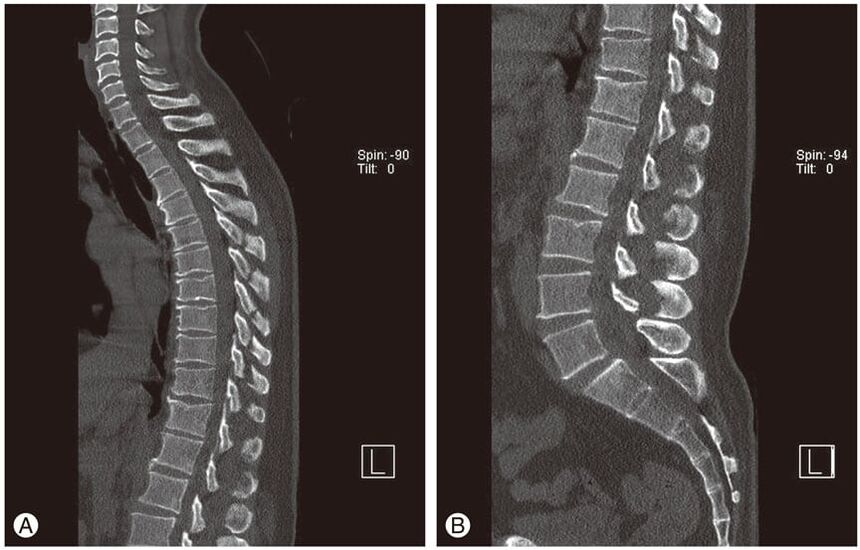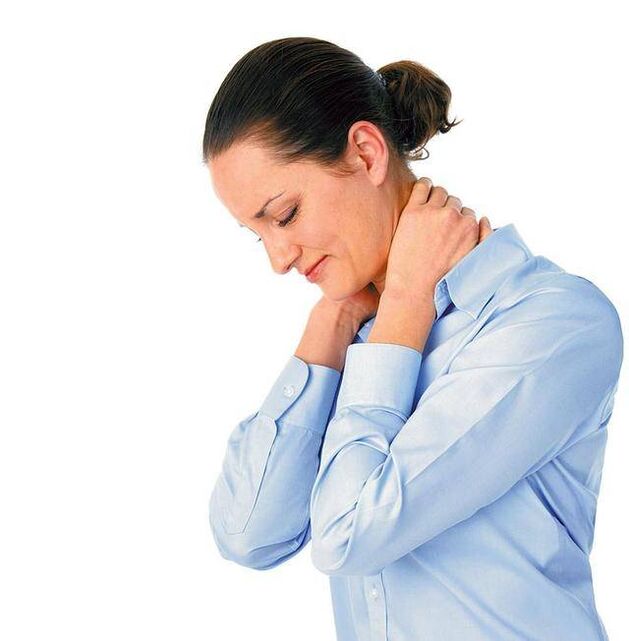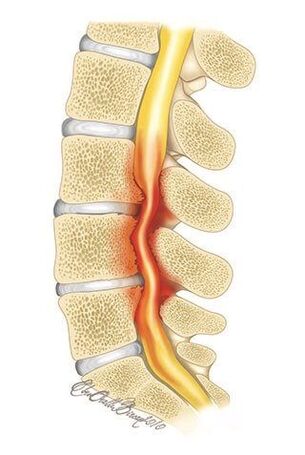Thoracic vertebral osteochondrosis is a severe degenerative dystrophic pathology with no definitive cure. It is performed against the background of disc destruction, vertebral displacement and herniation. When diagnosing the disease, doctors take into account that the symptoms of thoracic osteochondrosis are different in women and men. This is due to hormonal fluctuations in a woman's body. Women often stick to diets and wear narrow high-heeled shoes, making it difficult to experience family conflicts. This affects the development, course and progression of pathology in the musculoskeletal system.

Differences in clinical presentation between women and men
The diagnosis of thoracic osteochondrosis in women is more difficult due to the specificity of the hormonal background. In younger patients, monthly fluctuations are frequent. In women during natural menopause, the body's production of hormones decreases. This can lead to the development of pathologies, which must be distinguished. Men are characterized by the typical course of the disease, which can be detected in time and treatment can be started immediately.
The clinical presentation of thoracic osteochondrosis in women includes a number of very specific signs that are sometimes difficult to classify as symptoms of musculoskeletal disorders. Physicians distinguish these characteristic differences between male and female clinical presentations, further progression of thoracic osteochondrosis:
- Clinical manifestations in women occur slightly earlier. This is because the spine is more fragile, more susceptible to negative factors, and has an increased sensitivity to pain sensations;
- The intensity and stiffness of chest pain varies by menstrual cycle. This is due to the body's production of estrogen, a steroid sex hormone. They reduce the severity of pain that occurs against the background of thinning discs and neck muscle spasms. Therefore, during the initial diagnosis, based on the patient's complaint, women were not always able to describe the feelings that disturbed them in detail;
- In men, thoracic osteochondrosis rarely causes the development of concomitant diseases. In women, multiple conditions may occur at the same time. At the same time, osteochondrosis can trigger a disease unrelated to the musculoskeletal system. Conversely, endocrine or metabolic disorders lead to the destruction of cartilage tissue;
- For the treatment of thoracic vertebral osteochondrosis, in rare cases women are prescribed drugs for men. These are antipsychotics, tranquilizers, tranquilizers. Women's psycho-emotional state is more unstable, so symptoms include anxiety, increased anxiety, and insomnia. Sometimes depression comes along with the news that the disease is incurable and can only be eliminated by taking antidepressants.

Women are more prone to headaches. But unlike men, they do not experience an increase in the intensity of their clinical manifestations during the day due to the effects of estrogen.
An interesting fact is that as women's pathology progresses, libido increases. This is how steroid hormones work, which are produced in large quantities in the body to suppress pain. Men's libido is significantly reduced due to deranged prostate innervation.
Typical symptoms of the disease
Patients often complain to their doctor of pain in the scapular region that is exacerbated by tilting or turning the body. It radiates to the sides, lower back and even forearms. Pain is felt along the intercostal nerve and increases in intensity with coughing, laughing, and sneezing. Reflex pain complicates diagnosis and requires additional research, consultation with endocrinologists, cardiologists, breast doctors, gynecologists.
The characteristic hallmark is stiffness, a stiff feeling.When moving, changing the position of the body, a specific click is heard, usually related to the displacement of the vertebrae relative to each other. Typical symptoms of thoracic osteochondrosis in women also include the following clinical manifestations:
- A feeling of "goose bumps", decreased touch in the chest or abdomen, numbness in certain areas of the skin;
- There are signs of intercostal neuralgia. Severe tingling in the rib area that spreads to the chest and sides when lifting weights, increasing physical activity, and hypothermia;
- Stabilize the development of back pain - a combination of varying degrees of pain in the back. They can even occur when inhaling, intensify when climbing stairs, doing any household chores;
- Muscle spasms that limit the range of motion. Muscle cramps occur due to compression by osteophytes (bone growths) or inflammatory edema of sensitive nerve endings in soft tissue.
Thoracic osteochondrosis is characterized by persistent tension in the muscles located near the spine. This is detected by palpation during the initial examination and pain in the area of nerve endings. The woman's posture and gait have changed. She tried to keep her back straight to prevent pain. But with pathology of degree 3, curvature of the spine has been noted in the context of the development of scoliosis and the reduction of the distance between the vertebrae.
specific symptoms of pathology
Thoracic osteochondrosis is rarely diagnosed. This part of the spine is equipped with a strong muscular corset, and its strong adhesion to the ribs allows it to withstand strong static and dynamic loads. Doctors often refer to thoracic osteochondrosis as "chameleon disease. "To detect it, a differential diagnosis is required not only for pathologies of the musculoskeletal system (arthritis, spondyloarthropathy), but also for diseases of the internal organs.
Patients often complain not to chiropractors or neuropathologists, but to cardiologists, nephrologists, gastroenterologists, and gynecologists. The truth is that the symptoms of thoracic osteochondrosis are disguised as clinical manifestations of angina, cholecystitis, renal colic. The onset of intercostal neuralgia is very similar to myocardial infarction or appendicitis. What are the atypical symptoms of thoracic osteochondrosis in women during remission or relapse:
- pain in the heart area. They were mistaken for an angina attack or myocardial infarction. Cardiologists rule out heart disease after studying the results of electrocardiograms and other instrumental tests;
- breast pain. Discomforts do not go away for a long time and their intensity does not decrease. Breast ultrasonography to rule out benign and malignant tumors after the patient contacts a gynecologist or mammologist;
- Gastrointestinal pain (GIT). A woman turned to a gastroenterologist after the onset of right rib or epigastric or cyclical pain. Various laboratory and instrumental studies are performed in the diagnosis of gastritis, cholecystitis, ulcerative lesions;
- lower abdominal pain. Often occurs due to compression of spinal nerve endings. Pain sensations and urination disturbances resemble signs of urogenital disorders. A urologist or gynecologist distinguishes osteochondrosis from pyelonephritis, glomerulonephritis, and uterine fibroids.
Although the production of estrogen leads to increased libido, the patient exhibits reproductive dysfunction. Anorgasmia (lack of orgasm) develops against a background of compression of the nerves that innervate the lower thoracic spine in the back.

The tight localization of the pathology in internal organs and the commonality of innervation lead to very specific clinical manifestations. Sometimes they disguise themselves as cerebrovascular accidents, kidney failure, liver colic, or even dental disease. The medical literature describes cases of tooth extraction due to severe persistent pain at the root. Subsequently, the cause of the pain syndrome - neurological symptoms of thoracic osteochondrosis - was identified.
Vertebral signs are characteristic of cervical lesions but are sometimes detected in severe thoracic lesions. The destructive degenerative process of the vertebrae and intervertebral discs can cause a sharp rise in blood pressure, dizziness, impaired motor coordination, headaches and ringing in the ears. There are cases of vision loss.
Psycho-emotional disorders (lacrimation, anxiety, mood swings) are diagnosed in many patients. Health problems, news of upcoming surgery, and decreased physical activity can sometimes be the cause of a depressive state.
How to get rid of symptoms of thoracic osteochondrosis
Treatment of degenerative dystrophic pathology in women and men is the same. Damaged cartilage tissue cannot be recovered, so the main goal of treatment is to reduce the severity of symptoms and prevent further spread of the pathology.
When choosing a method, the doctor takes into account the degree of destructive changes, the presence of inflammatory processes in the soft tissues, the stage of the course of osteochondrosis of the thoracic spine. Women are more likely than men to take antidepressants, tranquilizers, and tranquilizers. During natural menopause, hormone replacement therapy may be prescribed, which is also necessary to prevent osteoporosis (loss of bone mass).
To eliminate the pain of osteochondrosis of the thoracic spine in women, drugs from various clinical and pharmacological groups are used:
- Non-steroidal anti-inflammatory drugs (NSAIDs)in a tablet. Prescribing topical NSAIDs for women after a week of taking and improving health;
- hormonal preparation. Glucocorticoids are often used for drug blockade;
- muscle relaxant. Relaxes skeletal muscles and relieves painful muscle spasms;
- chondroprotective agent. Partially regenerates damaged hyaline cartilage, they have analgesic effect after several weeks of treatment.
In the treatment of thoracic osteochondrosis, physiotherapy procedures are actively used: UHF therapy, laser therapy, magnetic therapy, the use of rehmannia, paraffin, the application of brucite. Show the patient massage, physical therapy exercises, swimming, yoga.
If a woman does not seek medical help, a disease of the internal organs can occur very quickly. They are caused by a herniated disc into the narrowed spinal canal and the formation of a hernia. Deterioration of the spine leads to compression of the spinal cord, which in turn leads to the development of renal, hepatic, gastrointestinal, or cardiovascular disease.
















